
Kaitoke Railway Station
Encyclopedia
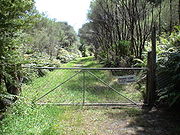
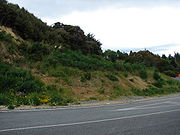
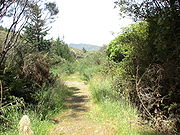
Wairarapa Line
The Wairarapa Line is a secondary railway line in the south-east of the North Island of New Zealand, connecting the capital city of Wellington with the Wairarapa region. The line ends at Woodville, where it joins the Palmerston North - Gisborne Line...
between Upper Hutt
Upper Hutt
Upper Hutt is a satellite city of Wellington. It is New Zealand's smallest city by population, the second largest by land area. It is in Greater Wellington.-Geography:Upper Hutt is 30 km north-east of Wellington...
and Featherston
Featherston
Featherston is a name of English origin, at least as old as the 12th century. The link with "Featherstone" is probably not traceable, but people researching both spellings contribute to the collection of pages in the website called "The Featherstone Society".The name is applied to people and...
in the Wellington
Wellington
Wellington is the capital city and third most populous urban area of New Zealand, although it is likely to have surpassed Christchurch due to the exodus following the Canterbury Earthquake. It is at the southwestern tip of the North Island, between Cook Strait and the Rimutaka Range...
region of New Zealand
New Zealand
New Zealand is an island country in the south-western Pacific Ocean comprising two main landmasses and numerous smaller islands. The country is situated some east of Australia across the Tasman Sea, and roughly south of the Pacific island nations of New Caledonia, Fiji, and Tonga...
’s North Island. Initially it was the railhead of the Wairarapa Line, at a point where the railway met the main road between Upper Hutt and the Wairarapa
Wairarapa
Wairarapa is a geographical region of New Zealand. It occupies the south-eastern corner of the North Island, east of metropolitan Wellington and south-west of the Hawke's Bay region. It is lightly populated, having several rural service towns, with Masterton being the largest...
. Later it was a point at which locomotives were changed, steam engines were watered, trains could cross, and passengers could make use of the refreshment room.
The station was closed along with the old route via the Rimutaka Incline on which the Fell system
Fell system
* Fell mountain railway system designed by John Barraclough Fell* British Rail 10100 designed by Lt Col L F R Fell...
was used over the Rimutaka Ranges when the Rimutaka Deviation
Rimutaka Tunnel
The Rimutaka Tunnel is a railway tunnel through New Zealand's Rimutaka Ranges, between Maymorn, near Upper Hutt, and Featherston, on the Wairarapa Line.The tunnel, which was opened to traffic on 3 November 1955, is long...
opened in 1955.
History
The Mungaroa Contract for the construction of the Wairarapa Line between Upper Hutt and the Pakuratahi Valley included a station near the terminus of the contract, originally called Pakuratahi Station. The contractor for this section was Charles McKirdy, who was to have completed the contract between 3 June 1874 and 3 March 1876 but, as was common with contracts for the construction of the Wairarapa Line, work was not completed on time. Having run out of money with two months of work left to complete, the contract was picked up by McKirdy’s guarantors, Walter Turnbull and John McKenzie. They applied for and received further funds to continue the work, which was completed on 16 December 1877.When work was nearing completion, the Government called for tenders to erect a fourth-class station building and stationmaster’s house. The contract was let to W. H. Ridler for the sum of £1,778. This contract also possibly included the erection of the goods shed on a siding 12 chains (240 metres) to the north of the station (the goods shed was demolished in 1882). A separate contract for the sum of £1,514 was let to Messrs. Fraser and Lyon for the construction of an access road to the station and the levelling of the site for the station and house.
By early December 1877, the Public Works Department had advanced platelaying as far as Pakuratahi Station, by this time renamed Kaitoki, later (probably in the 1880s) to become Kaitoke). As Kaitoke was expected to be the railhead for two years, there was some consternation over the siting of the station, with complaints particularly from the Wairarapa that the site was unsuitable for the trans-shipment of goods between road and rail. The Government stood firm and the station stayed where it was intended to be.
The line up to Kaitoke Station was officially opened on 28 December 1877 by the Marquis of Normanby. A special train was run from Wellington to Kaitoke for the occasion under the supervision of District Engineer Mr. Hales and General Manager Mr. Stone. After speeches and an inspection of the station, by which time had had a refreshments room added, the Governor and party boarded the train again to return to Wellington. Over the next few days, excursion trains were run from Wellington to Kaitoke to satiate the curiosity of those who had heard of the fearsome reputation the line had gained during its construction.
Kaitoke Station proceeded to enter the busiest phase of its existence as the railhead of the Wairarapa Line, which lasted only until the opening of the line as far as Featherston
Featherston Railway Station
Featherston railway station is a single-platform, urban railway station serving the town of Featherston in the Wairarapa district of New Zealand. The station lies on the Wairarapa Line, and is located between Harrison Street West and Harrison Street East...
on 16 October 1878, after which it was of minor significance. Initially, two daily mixed trains were timed to connect with road coaches from the Wairarapa. There was a limited amount of flat land available, so the station retained its original configuration of the main line plus one crossing loop throughout its life. There was also a locomotive siding to the south of the station until the practice of changing locomotives ceased, at which time the siding was lifted.
The refreshment rooms were extended in 1896, and, except for the addition of the signal box in 1902, the station buildings remained the same until the refreshment rooms were closed about 1952.
In 1883 the station handled 759 outbound passengers, a level of patronage that remained steady for many years. Traffic increased steadily right from the start, with average goods tonnage at around the same time of 457 tons inward and 1,978 outward. The growth in business led to the introduction of a third mixed train a month after the station opened.
The Working Timetable of 1887 lists Kaitoke as one of the first stations on the section to receive signals. Instructions for crossing trains required down (southbound) trains to take the siding or loop and up (northbound) trains to take the main line.
Soon after the installation of the first full mechanical interlocking system at Lambton Station in Wellington, a smaller system was installed at Kaitoke. A signal box was built at the south end of the platform, and two arm bracket signals for both “home” and “starting” were provided for trains travelling in both directions. Later, up and down “distant” signals were added. Balanced arm semaphore signals replaced the earlier slotted-post design.
With the completion of the Rimutaka Deviation, Kaitoke station was closed on 30 October 1955 along with the rest of the old line over the Rimutaka Ranges, followed by the opening of the new line on 3 November.
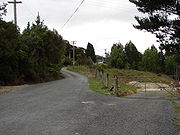
Today
Station Drive, the access road to the former station off State Highway 2, still exists and provides access to several private dwellings that have been constructed on the terrace that was cut into the hillside to form the station yard. The terrace can easily be seen from the old State Highway where it intersects with the new State Highway, and there is public access up to the south end of the former station yard via the old railway line, a public walking/cycling track between Kaitoke and Mangaroa.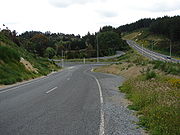
Future
The Rimutaka Incline Railway, the project of the Rimutaka Incline Railway Heritage TrustRimutaka Incline Railway Heritage Trust
The Rimutaka Incline Railway Heritage Trust is a non-profit, charitable trust in New Zealand that was established in 2003 with the objective of reinstating an operating heritage railway over the Rimutaka Ranges using the original route of the Wairarapa Line between Maymorn and Featherston,...
, aims to re-establish a railway line on the former Wairarapa Line formation between Maymorn and Featherston. This includes new track past Kaitoke, utilising an easement created by Transit New Zealand
Transit New Zealand
Transit New Zealand was, from 1989 to 2008, the New Zealand Crown entity responsible for operating and planning the New Zealand State Highway network...
when they built the State Highway 2 deviation through Kaitoke . The trust does not propose to acquire former railway formation now in private ownership at Kaitoke, or establish a new station at or near the original Kaitoke Station for its own operations.
See also
- Cross Creek Railway StationCross Creek Railway StationCross Creek railway station was the base of operations for the Rimutaka Incline, a Fell railway over the Rimutaka Ranges, and part of the original Wairarapa Line between Upper Hutt and Featherston in the Wellington region of New Zealand’s North Island....
- Summit Railway StationSummit Railway StationSummit railway station was at the summit of the Wairarapa Line over the Rimutaka Ranges in the Wellington region of New Zealand’s North Island and was where trains were marshalled for a descent down the Incline or for Fell locomotives to be extricated from a train that had ascended the Incline...
- Rimutaka Incline
- Rimutaka TunnelRimutaka TunnelThe Rimutaka Tunnel is a railway tunnel through New Zealand's Rimutaka Ranges, between Maymorn, near Upper Hutt, and Featherston, on the Wairarapa Line.The tunnel, which was opened to traffic on 3 November 1955, is long...
External links
- Greater Wellington Regional Council. Tunnel Gully Recreation Area.
- Photo of Railcar arriving at Kaitoke, 29 October 1955

